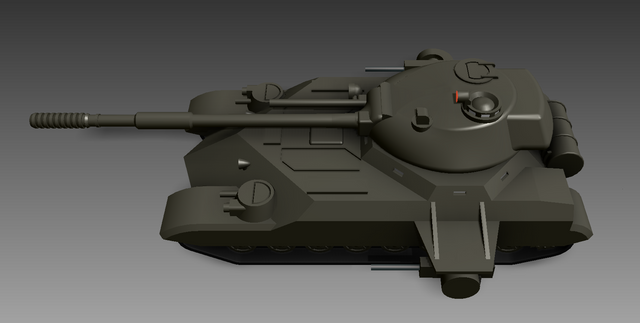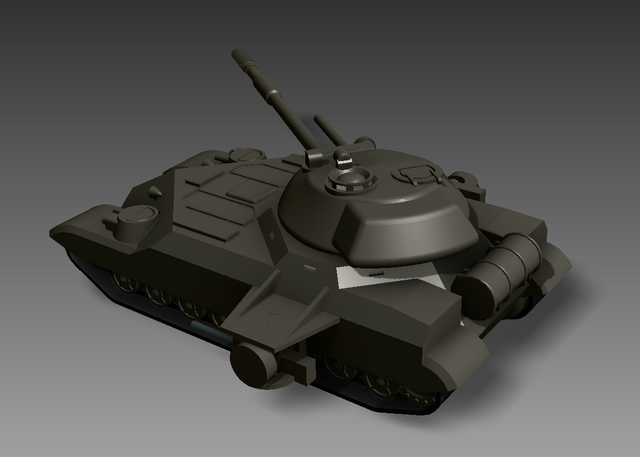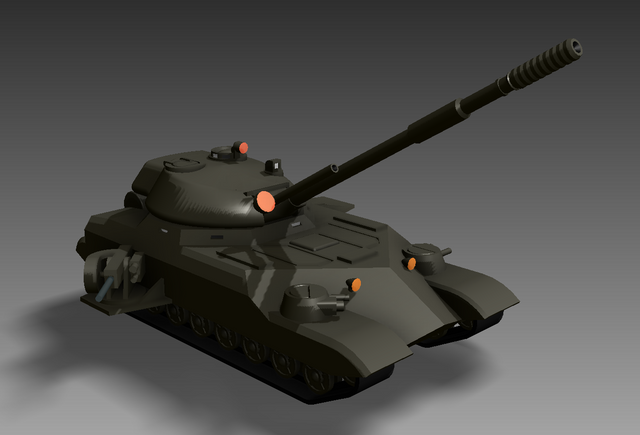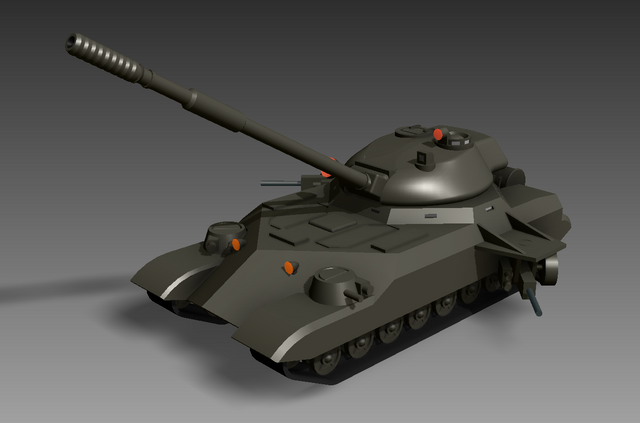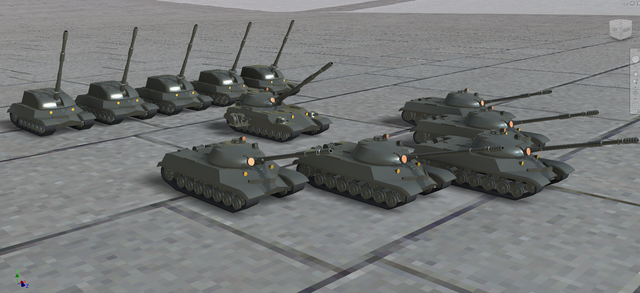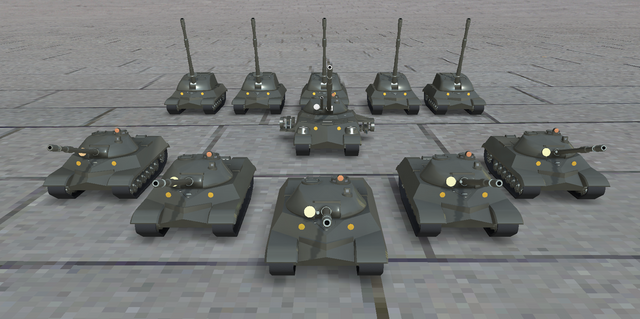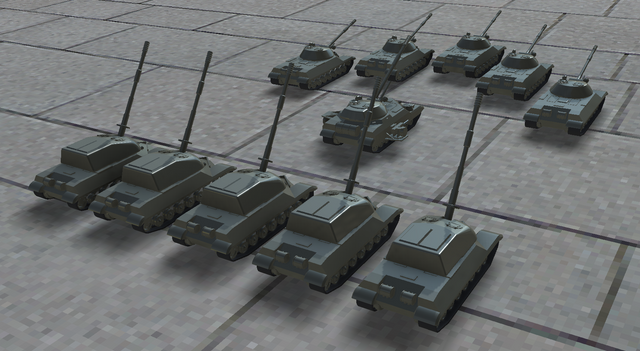The IS-11
In a previous post, I showed off some early work on a fictional tank that I designed that began as a backwards T-10 and slowly morphed into a multi-turret vehicle inspired by the Baneblade from Warhammer 40,000. Since I began the work in Autodesk Inventor 2019, I could not continue construction in Inventor 2011, and therefore worked from drawings that I made in Inventor 2019 and exported to portable document format (pdf). Now, I am happy to announce that I've finally finished this monstrosity, and hopefully I can fix my mind back on to finishing the AMX M4. Behold:
The original backwards T-10 I called "Object 735," since the T-10M was produced as Object 734 in Chelyabinsk and Object 272 in Leningrad. Upon adding the forward turrets, widening the upper section of the hull, and increasing the firepower, I added the suffix GK as homage to the Astra Militarum vehicle that I had in my mind as I was, for lack of a better phrase, fooling around. After all that, I came up with an alternate history scenario, necessitating that this tank be named IS-11.
The IS-11 is, essentially, a miniature Baneblade. It has only six guns (and two flamethrowers), and it weighs only 60 tonnes, but my alternate history Red Army isn't fighting orks or tyranids. In addition, this tank is grounded in a different reality. I'll explain: in the 40K universe, anything goes, but in our world, tanks can't get above a certain size for a very simple reason. The Nazis drew up some gargantuan tanks, such as the Pz 1000 "Ratte," but those were never built. The largest tank the Germans ever built was the PzKpfw VIII "Maus," and it was only 3,7 metres wide. The largest tank ever built was the French FCM Char 2C, which was only 3 metres wide, and British tanks of World War I were 4 metres wide, including sponsons. The reason is that tanks were transported by rail, and certain German tanks, such as the PzKpfw VI "Tiger," were too wide to fit through rail tunnels, so had to have their outer road wheels and combat tracks removed for transportation. In order to make larger tanks, they were simply made longer, but the optimum length-to-width ratio of any tracked vehicle's footprint (or "track-print") is between 1,5 and 1,8. Therefore, tanks cannot get above a certain length, either. Early tanks tended to be much longer, but this was before engineers discovered the optimum ratio. Since modern tanks are still transported on trailers, be they the road or rail variety, they are limited in size, whereas the Imperium of Man doesn't have this problem.
The IS-11 doesn't have actual sponsons, like the Baneblade, but sponson plates mounting remotely operated machine guns, much like some modern AFVs or the Astartes Predator. This is so that the machine guns can be easily removed for transportation and then installed quickly and easily by Red Army soldiers when the tank reaches its destination. Like the T-10 (which called the IS-10 in the alternate history scenario), the IS-11 is 3,6 metres wide on the outside of its track skirts. However, each of those sponson plates sticks out a full metre from the tank, bringing its combat width up to 5,6 metres, much too wide for most single-lane roads, railway tunnels, or bridges. To be fair, it's also too heavy for most bridges anyway, and one of the reasons that, in our actual timeline, Nikita Khrushchëv forbade the development of any AFV over 37 tonnes in 1960 was because most Russian bridges could not reliably support more weight than that. Rail bridges were certainly an exception, but I'm talking about old stone bridges that tanks would have to cross during deployment.
The IS-11 is armed with a 152,4mm rifled cannon, though it is not primarily a tank gun, and the tank carries more high-explosive (HE) ammunition than armour-piercing (AP) ammunition. The gun can elevate to 30 degrees, whereas the gun on the IS-10 can elevate to only 15 degrees, giving the IS-11 an incredible firing range for a tank.
The tank is no slouch against other AFVs, however, owing to the coaxial 105mm smoothbore anti-tank gun, similar to but much more powerful than the 73mm 2A28 Grom employed on the BMP-1. Each of the remotely operated forward turrets mounts a 7,62mm machine gun and a flamethrower, and can traverse 49 degrees toward the centre of the tank, and 91 degrees to the side, and thus able to sweep the entire area in front with both bullets and fire. Each of the remotely operated side-mounted 14mm machine guns can also rotate up to 45 degrees to the outside of the tank.
You will notice that the left-hand machine gun is hanging from the sponson plate, as on the Astartes Predator, whereas the right-hand machine gun is mounted on top of the sponson plate, as remotely operated machine guns typically are in armies that use them today. This is because the control box (which also contains the optics) would hit the track skirt and prevent it from rotating at all if it was mounted the same way as the one on the other side. Now then, I could easily make a mirror-image component, but mass-produced heavy machine guns that are used as the weapons for remotely operated gun systems do not come in left-hand and right-hand variants, as bolt-action rifles or side-lock muzzle-loaders do. In fact, funny story: when I turned 12 and was thus old enough to hunt in Pennsylvania, my father bought me a Savage 110 bolt-action .30-06. I hate using that gun, because it has a hollow plastic stock and an inch-thick, spongy recoil pad that does fuck all. Therefore, I tried getting a replacement wooden stock, but the company I found, that supposedly specialises in that sort of thing (and no, I don't remember which company it was, I was 14 at the time) sent me a left-handed stock for the wrong model, even though I specified that it was a right-handed model 110. To this day, my father and I swap rifles during gun-hunting season, assuming that I haven't already filled my tags during archery season, because with that lightweight plastic stock, that .30-06 has a nastier kick than my .45-70, which most people are surprised to learn is my favourite cartridge, scrawny little critter that I am.
Concerning remotely operated weapon systems in general, I imagine that most people would think that a tank developed in alternate-reality 1957 ought not to have them, but the IS-7 actually DOES have remotely operated machine guns AND an autoloader for its main gun, and it was built in 1948! And people wonder why I idolise Nikolai Shashmurin...
The following pictures show what my alternate history Supreme Command heavy tank division would look like, centred about an IS-11:
In the front row is the IS-10M, and in the back is the ISU-10M, another fictional AFV I came up with on my own, but coincidentally is very similar to Object 268-5, a self-propelled gun designed around the T-10 chassis, mounting a 152,4mm rifled howitzer in a rotating turret. It was never built, but its fixed casemate predecessor, Object 268, is currently on display in the Kubinka Tank Museum. The main differences between the ISU-10M and Object 268-5 are that the former has a bigger turret and mounts a 160mm rifled howitzer, but the idea behind the two designs is exactly the same.
Right, enough fiction. Time to get back to reality, and (maybe) finish the AMX M4!
